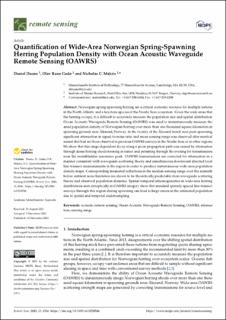| dc.contributor.author | Duane, Daniel | |
| dc.contributor.author | Godø, Olav Rune | |
| dc.contributor.author | Makris, Nicholas C. | |
| dc.date.accessioned | 2022-01-19T15:07:45Z | |
| dc.date.available | 2022-01-19T15:07:45Z | |
| dc.date.created | 2021-12-03T10:13:47Z | |
| dc.date.issued | 2021 | |
| dc.identifier.citation | Remote Sensing. 2021, 13 (22), . | en_US |
| dc.identifier.issn | 2072-4292 | |
| dc.identifier.uri | https://hdl.handle.net/11250/2838341 | |
| dc.description.abstract | Norwegian spring-spawning herring are a critical economic resource for multiple nations in the North Atlantic and a keystone species of the Nordic Seas ecosystem. Given the wide areas that the herring occupy, it is difficult to accurately measure the population size and spatial distribution. Ocean Acoustic Waveguide Remote Sensing (OAWRS) was used to instantaneously measure the areal population density of Norwegian herring over more than one thousand square kilometers in spawning grounds near Ålesund, Norway. In the vicinity of the Ålesund trench near peak spawning, significant attenuation in signal-to-noise ratio and mean sensing range was observed after nautical sunset that had not been observed in previous OAWRS surveys in the Nordic Seas or in other regions. We show that this range-dependent decay along a given propagation path was caused by attenuation through dense herring shoals forming at sunset and persisting through the evening for transmissions near the swimbladder resonance peak. OAWRS transmissions are corrected for attenuation in a manner consistent with waveguide scattering theory and simultaneous downward directed local line-transect measurements in the region in order to produce instantaneous wide-area population density maps. Corresponding measured reductions in the median sensing range over the azimuth before ambient noise limitation are shown to be theoretically predictable from waveguide scattering theory and observed population densities. Spatial-temporal inhomogeneities in wide-area herring distributions seen synoptically in OAWRS imagery show that standard sparsely spaced line-transect surveys through this region during spawning can lead to large errors in the estimated population due to spatial and temporal undersampling. | en_US |
| dc.language.iso | eng | en_US |
| dc.title | Quantification of wide-area norwegian spring-spawning herring population density with ocean acoustic waveguide remote sensing (OAWRS) | en_US |
| dc.type | Peer reviewed | en_US |
| dc.type | Journal article | en_US |
| dc.description.version | publishedVersion | en_US |
| dc.source.pagenumber | 28 | en_US |
| dc.source.volume | 13 | en_US |
| dc.source.journal | Remote Sensing | en_US |
| dc.source.issue | 22 | en_US |
| dc.identifier.doi | 10.3390/rs13224546 | |
| dc.identifier.cristin | 1964033 | |
| cristin.ispublished | true | |
| cristin.fulltext | original | |
| cristin.qualitycode | 1 | |
